1
Incorporate carbon emission and cost calculations into a navigation app

Last spring, I designed a carbon neutral transportation app for the Bay Area as part
of the Go Carbon Neutral 2021 Designathon. Almost everyone is aware of the rising
urgency of climate change, yet it is difficult for individuals to find ways to reduce
their carbon footprint in their daily lives. Our app addresses this issue by providing
carbon emissions data on different commute options, and suggesting alternate low-carbon
emission routes, enabling users to make carbon neutral choices in their daily lives.
The app makes carbon transportation accessible and fun by gamifying transit.
Whenever users choose a lower carbon transportation option, they are rewarded
with points that can be exchanged for real-world prizes, increasing user motivation
to make more carbon neutral choices. Through this challenge, I researched the
impact of private transportation on carbon emissions, created a set of high fidelity
mockups with Figma, and presented my designs to a panel of judges. With my app design,
my partner and I placed 3rd among 15 finalist teams, and took home a prize of $1600.
Location: Berkeley, CA
Timeline: March-April 2021
Stakeholders: BART, local businessess, Berkeley residents
Team: Xiaoyu Hu, Sydney Wong
Role: UI/UX designer, researcher
Tools: Figma

A Decline in Public Transit Use
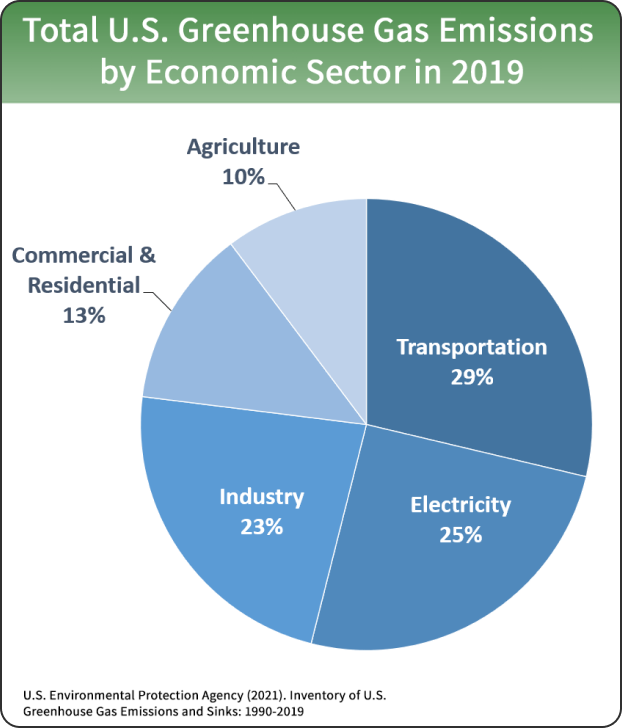
Currently, private vehicles used for daily transportation contribute half of the carbon dioxide emissions from transportation in the U.S, with the average vehicle producing 6 to 9 tons of CO2 each year. Encouraging low-carbon alternatives can have a profound impact on the transition to carbon neutrality. For example, on a 20-mile round trip, using public transportation can lower an individual’s carbon footprint by 4,800 pounds annually. However, according to research by UCLA on the Bay Area, ridership has decreased staggeringly between 50 to 94 percent during the first half of 2020 under the pandemic, but even earlier, public transit usage has decreased by 11% from 2014-2018. If the adult population of the bay area were to choose public transit 15% of the time, at a low estimate, this could save 3 million metric tons a year.
For this designathon, we focused on finding a solution to help reduce carbon emissions caused by transportation in people’s daily lives, starting with the bay area.

Researching Berkeley’s Commute Habits
Focusing on Berkeley residents, I referenced two government demographic websites, and synthesized the data into two main user groups.
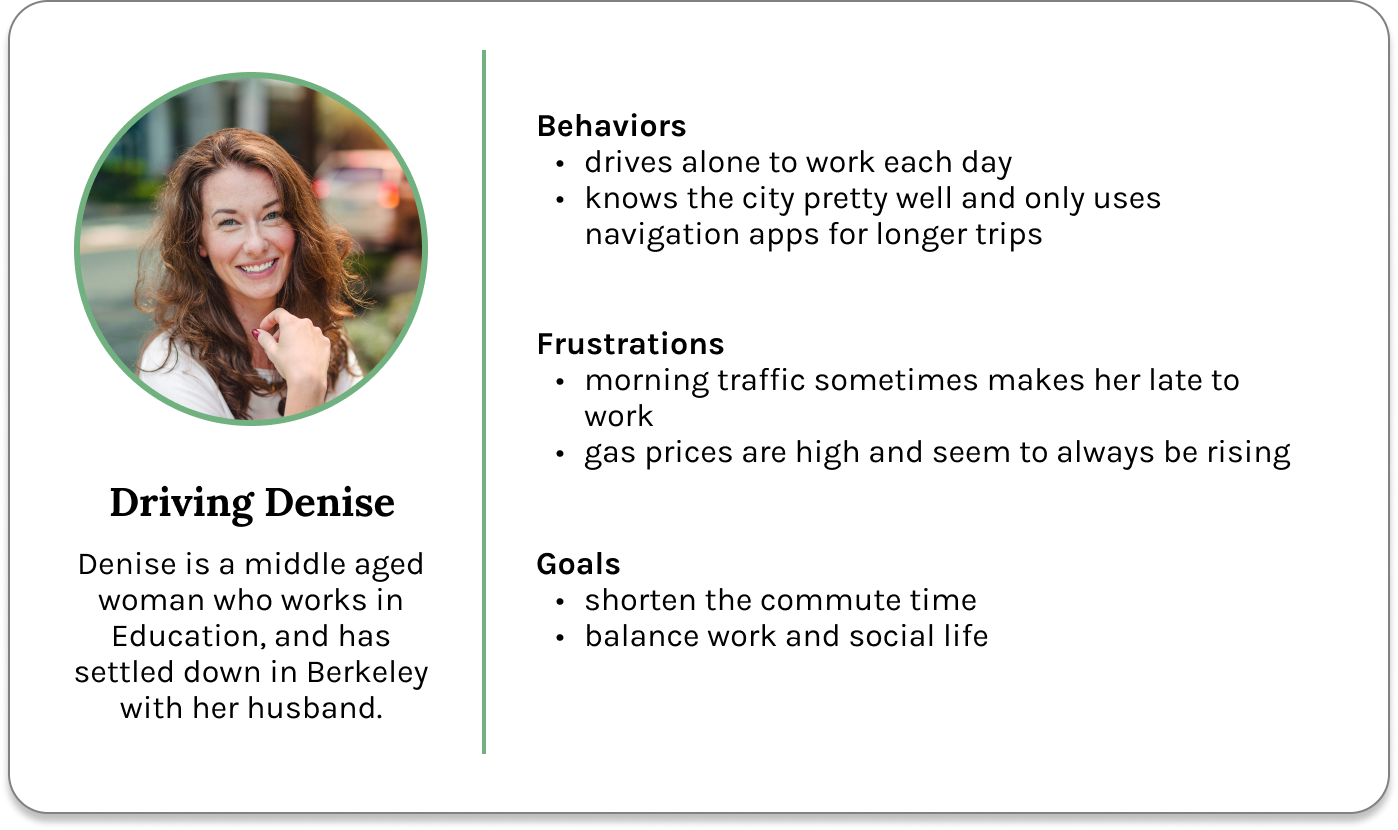
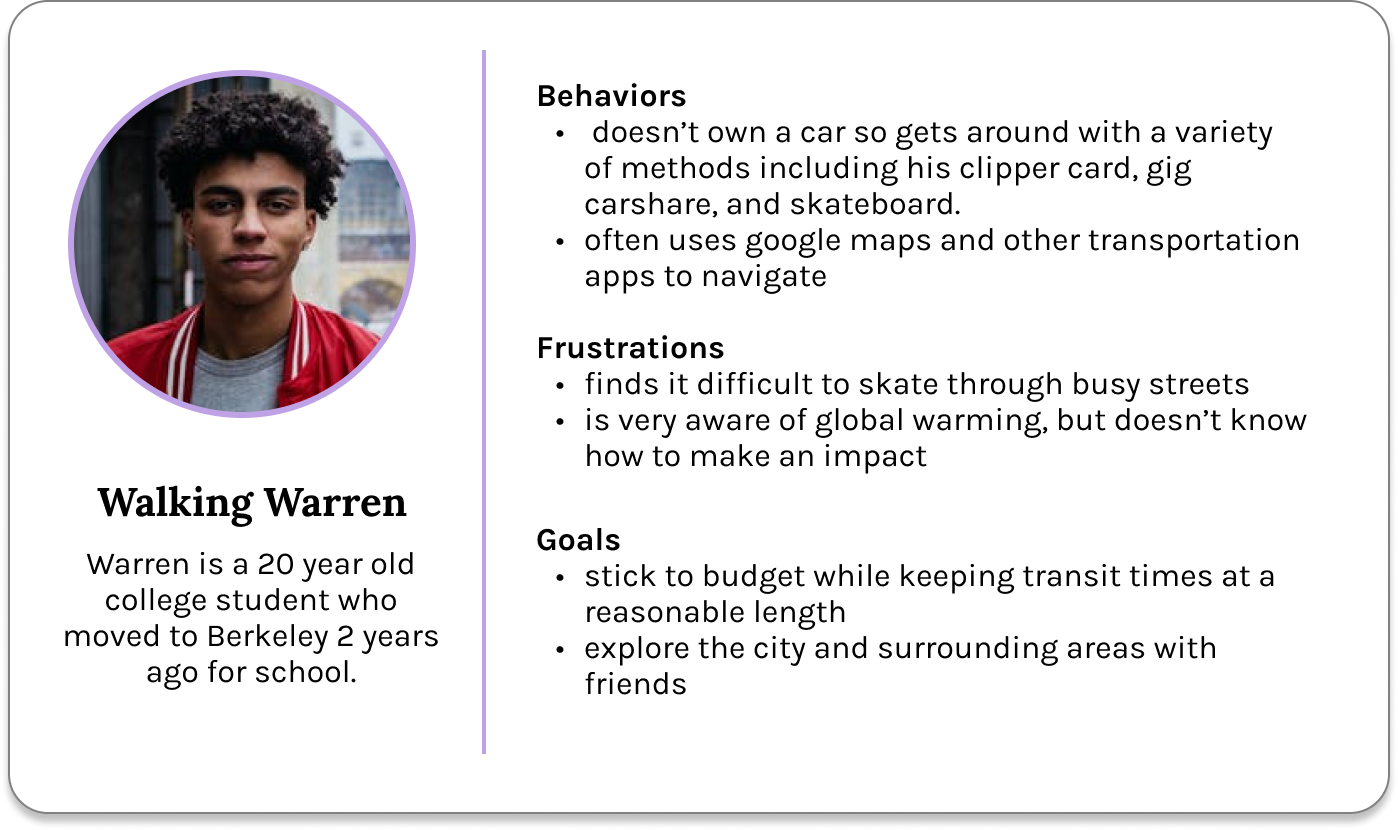
86% of the Berkeley population are private vehicle owners, who often need to travel far distances for work, or just enjoy the ease and comfort of driving themselves. They are unlikely to switch completely to public transit for long commutes when they already own a car. A solution for these users should create ways for them to drive more efficiently for long trips, or provide strong incentives to switch to walking, biking, or public transit for shorter trips
Non-vehicle owners, especially students with free public transport cards that make up 33% of the Berkeley population, are more likely to use public transit or walk, but also often use rideshare apps for convenience. If there is enough incentive, these users are more likely to choose public transit over expensive rideshare apps for both shorter and longer trips.

Incorporating Feedback and Iterating Through App Designs
Goal: create a solution that equips the individual with transportations related carbon emissions information, and empower them to make carbon neutral choices in their daily lives.
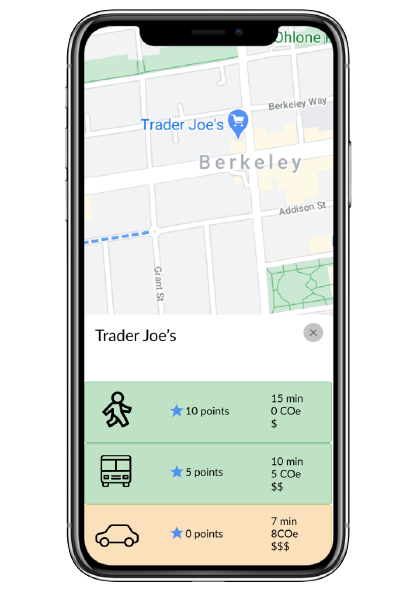
Incorporate carbon emission and cost calculations into a navigation app
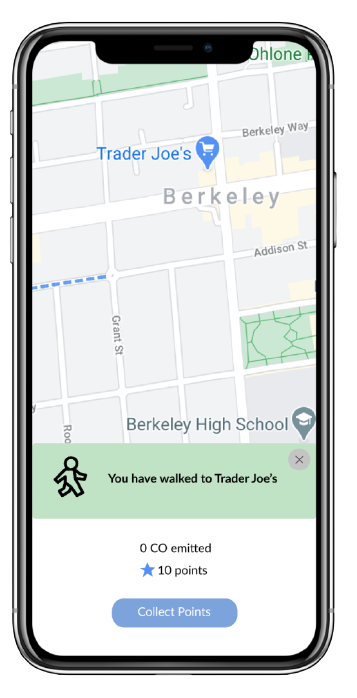
Points and rewards system for choosing carbon neutral routes
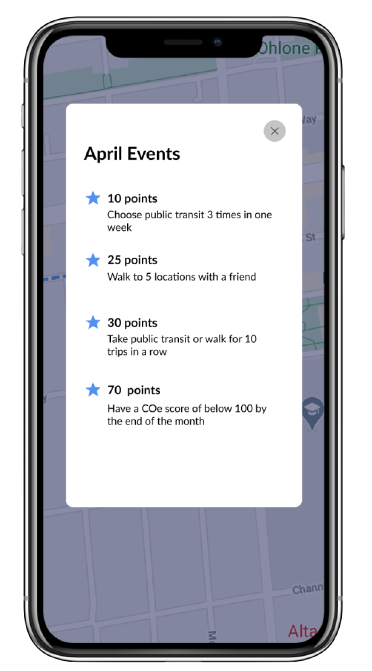
Special events encourage community outings and promote public health
Firstly, we needed the solution to be easily accessible, and part of the user's daily lives, so we settled on creating a free navigation app. Since most people have phones now, and need to use navigation tools to plan trips or check bus routes, the app would be easily integrable into a daily routine.
Secondly, we needed to ensure that the app would be engaging and keep users motivated to make carbon neutral choices each day. We looked at several social media apps and mobile games for inspiration on how to make our app similarly engaging. We decided to implement a points and rewards system found in several games to motivate users. For choosing lower carbon emission routes, users could be rewarded with points to use in an in app shop. The shop would include prizes, such as free BART tickets and running shoes, to help users continue making carbon neutral choices. We also included monthly special events such as “walk to 5 locations with a friend”, where users could interact with each other and win extra points.
After submitting our proposal, we received feedback from a panel of judges and mentors, which we synthesized into a few main improvements which used to guide the final design and features of the app.
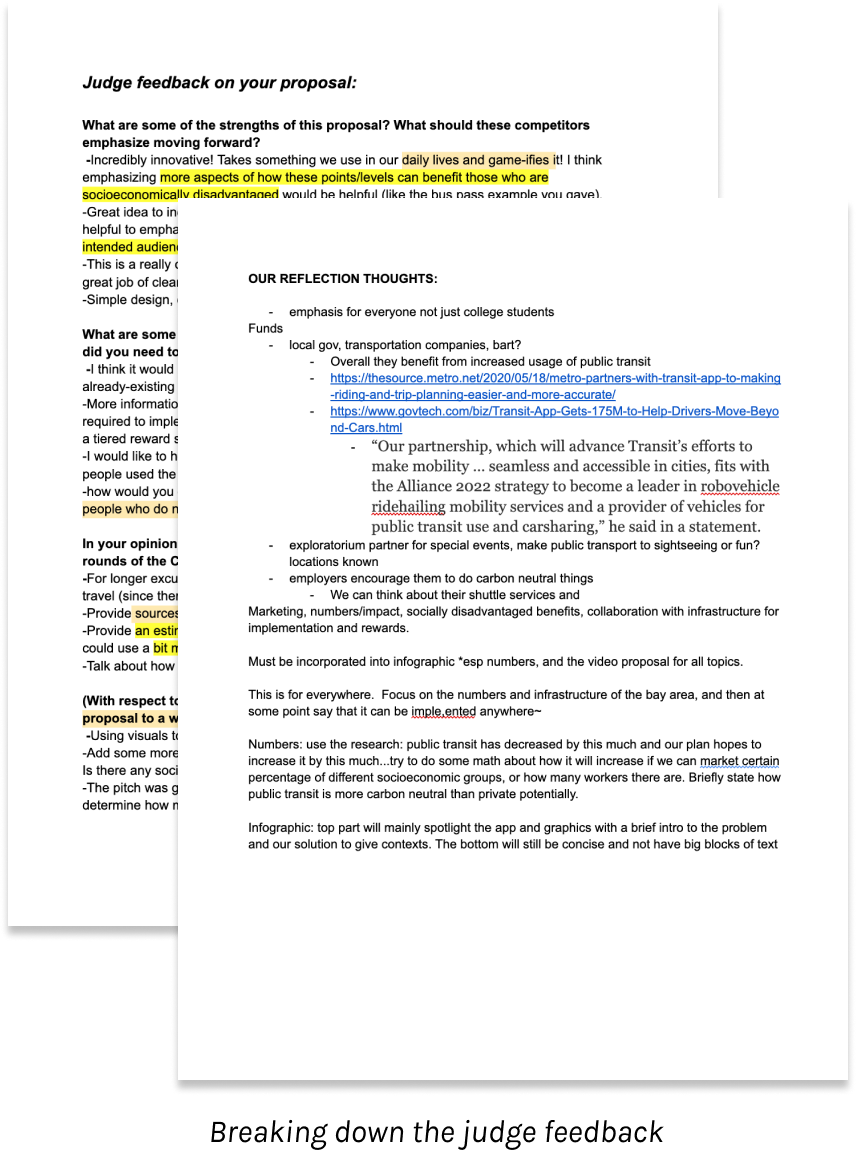
A major feedback we received from the judges was that we did not quantify how much our app would reduce carbon emissions. I found it very challenging to come up with exact numbers, as we had no idea how companies usually calculate their carbon footprints. We had relevant pieces of information, such as average carbon emissions per mile from driving, but weren’t sure how to put it all together.
Seeking guidance, I met with a mentor who had experience in the self-driving car industry. Our mentor suggested a formula to estimate the amount of carbon emissions reductions based on a certain usership of the app using Berkeley demographics, which we were able to use successfully to quantify the app’s effectiveness.
Though we intended to make the app accessible to all users by making it free, the judges wanted to know how we would accomplish this financially, given our points and rewards system where users could win real world prizes. We decided to begin by sourcing prizes locally and partnering with local businesses. In exchange for driving traffic towards local businesses by listing them first in our search results, we would receive some products. This would help businesses promote their products, and allow people of all socioeconomic backgrounds to participate in the prize aspect of the app. Furthermore, to increase accessibility for people of visual abilities I added speech-to-text options, and chose large fonts with enough contrast.
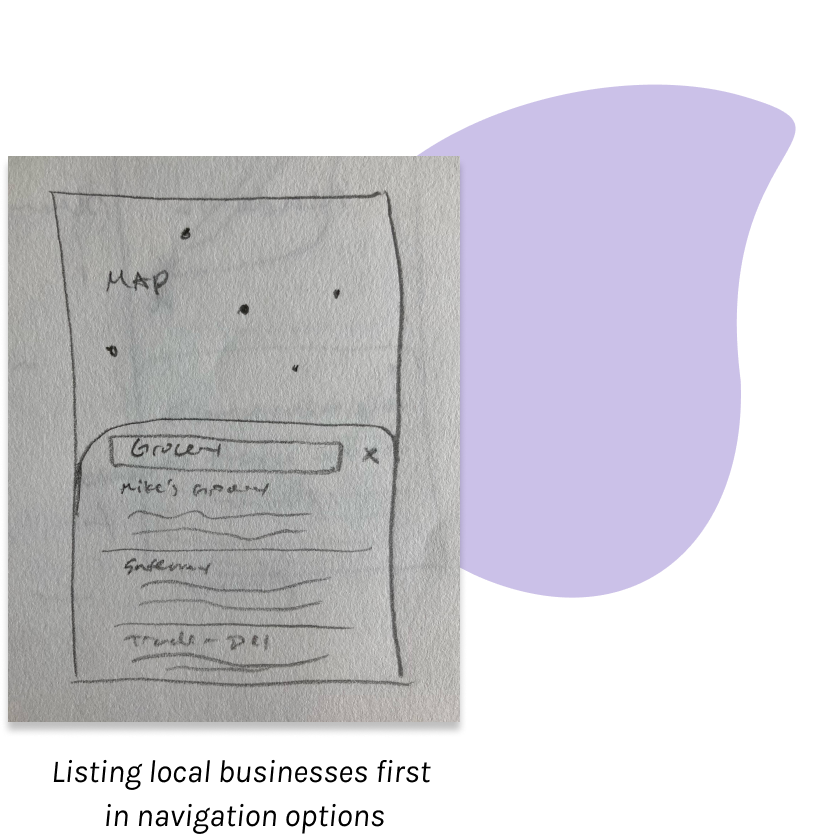
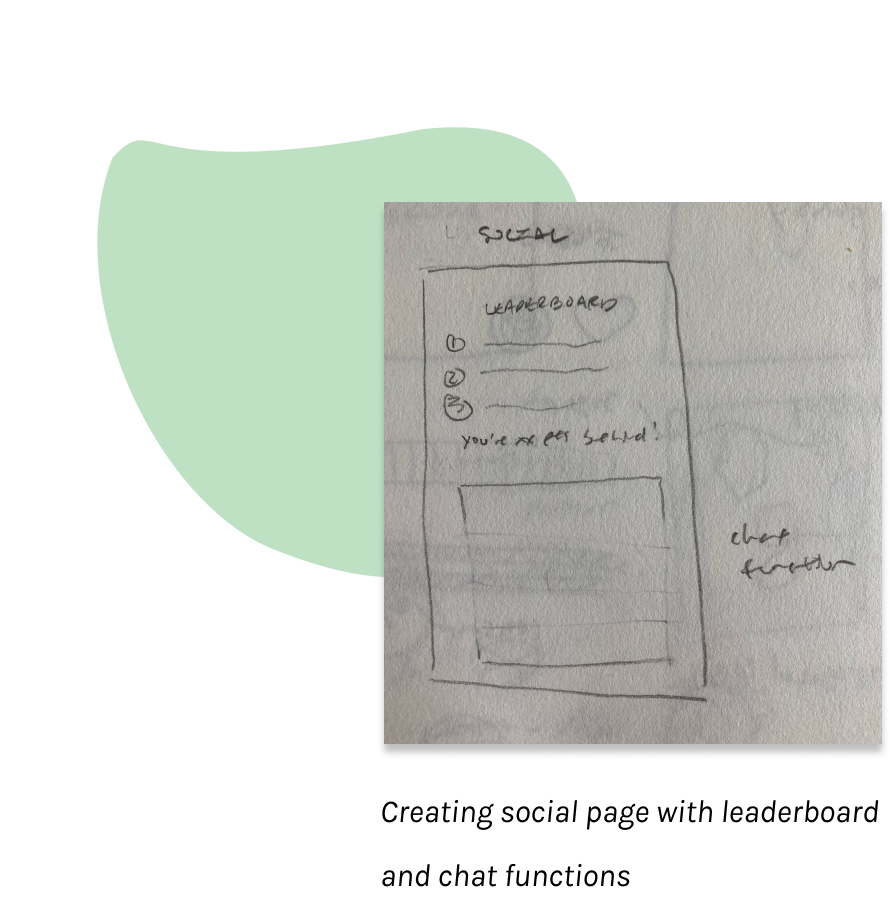
Though our initial design included some monthly social events, and prizes aimed to sustain user motivation, our mentors suggested that we also increase the social aspect of the app to further increase and sustain motivation. To this end, I added an activity feed and leaderboard so users could stay up-to-date, and foster friendly competition amongst each other. Inspired by social media apps, I also included an in-app chat function that friends could use to plan outings together.
A mentor, who is a regular biker, informed us on how bikers and walkers sometimes actually preferred scenic routes, since the quickest route is often by roads with cars flying by. In response to this I created a “quickest route” and “scenic route” options which encourages new bikers and walkers with less intimidating paths, and caters to existing bikers and walkers.
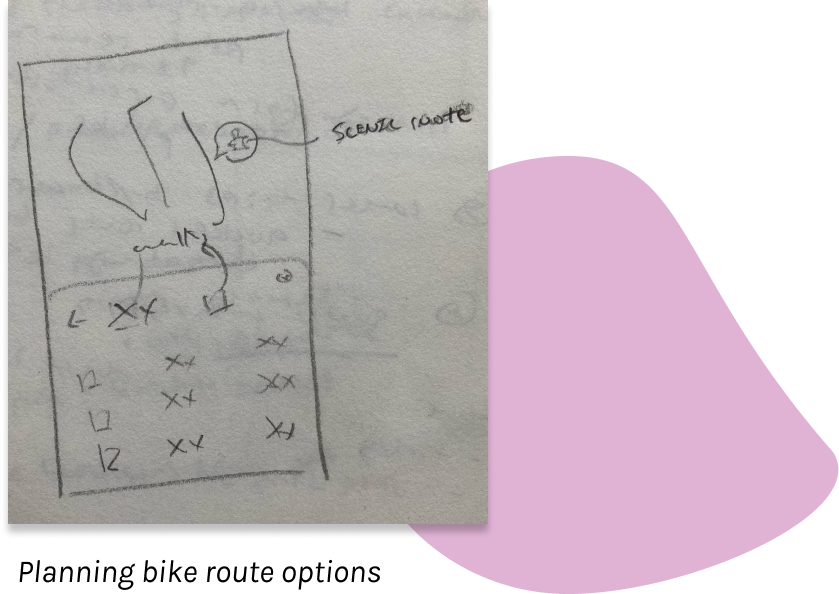
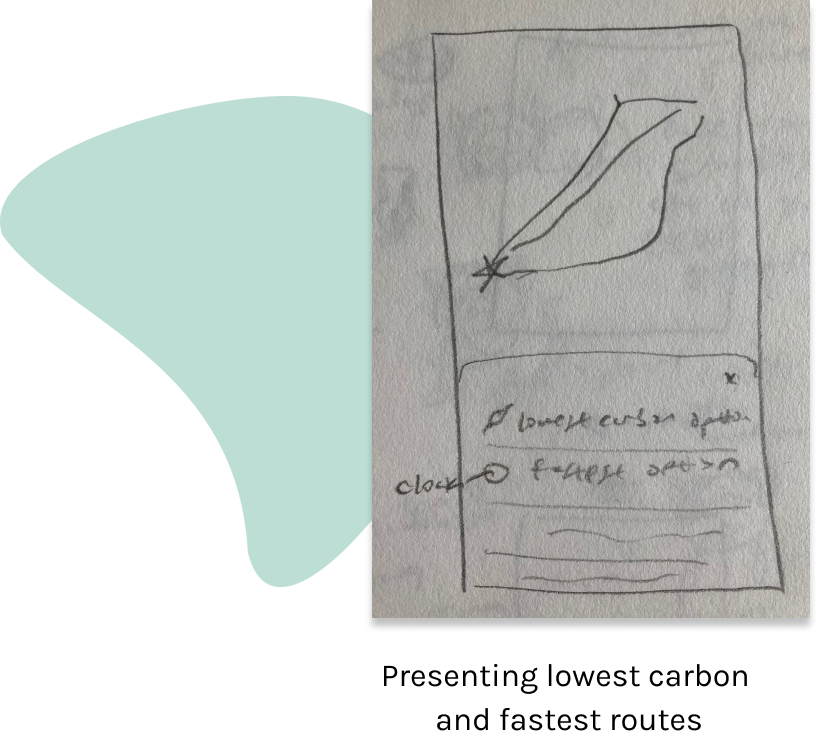
A mentor who lived outside of Berkeley pointed out that in other cities with less established public transit options, driving will be necessary at times. Taking this into account, we included low idling routes to reduce emissions for necessary car trips.

Equipping Users with the Information to Go Carbon Neutral
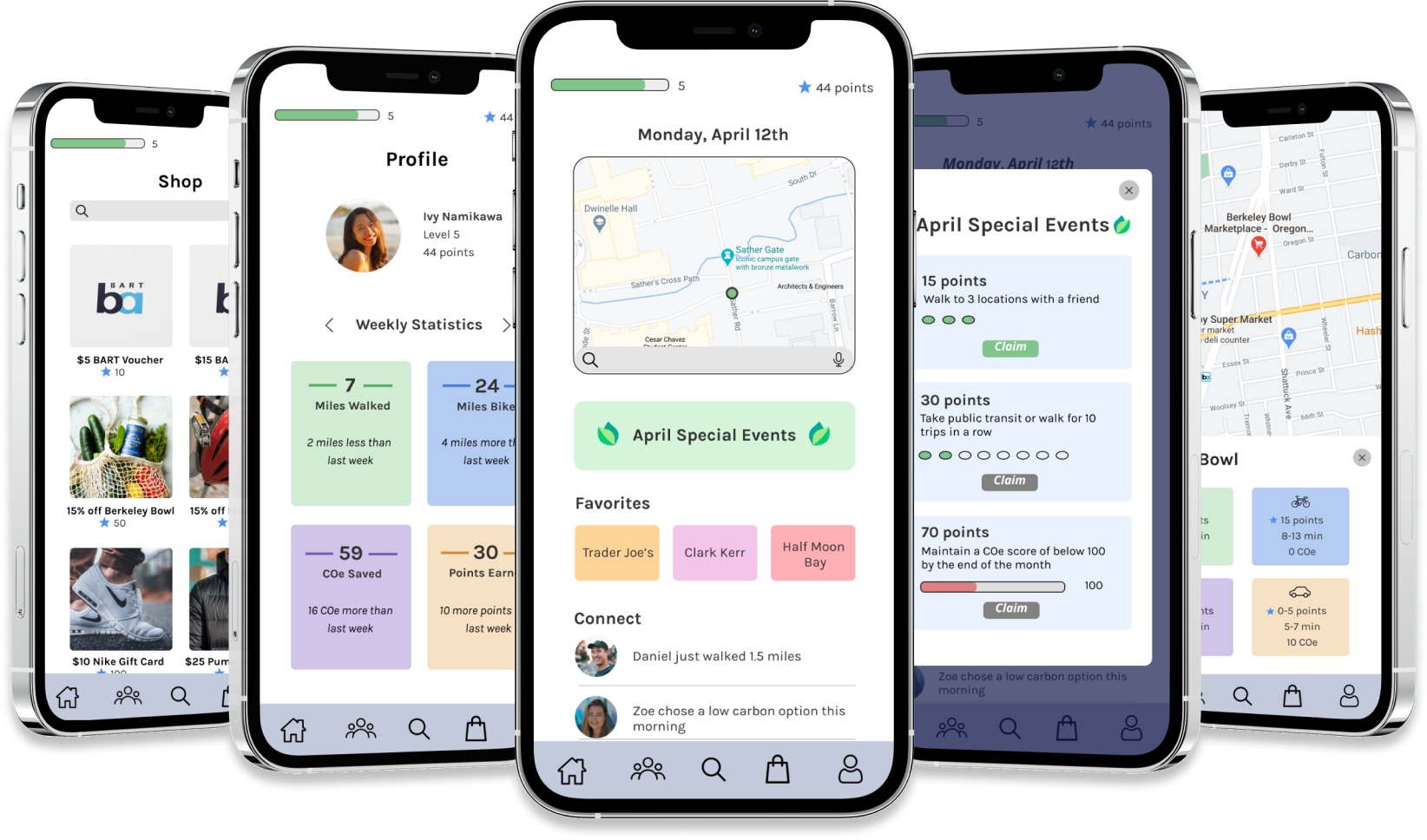
Taking 3rd place in the designathon and winning a prize of $1600, our app is projected to cause a 22% reduction in emissions from short trips using private vehicles, given a 25% user rate in Berkeley, CA.


Our app gamifies transit with levels, points, special events, and prizes, making choosing carbon neutral options rewarding and fun. The home screen interweaves the navigation and social aspects of the app with a central map, and a social feed that updates users on their friends' recent carbon neutral choices. Monthly special events that help build community, and can also be switched out each month to promote different local sponsors.


In addition to prizes, we added a social and profile page to keep users motivated. A social page with leaderboard and chat provides a social incentive to continue making carbon neutral choices. The profile page tracks week-to-week statistics, so users can check their status, and track progress over time.
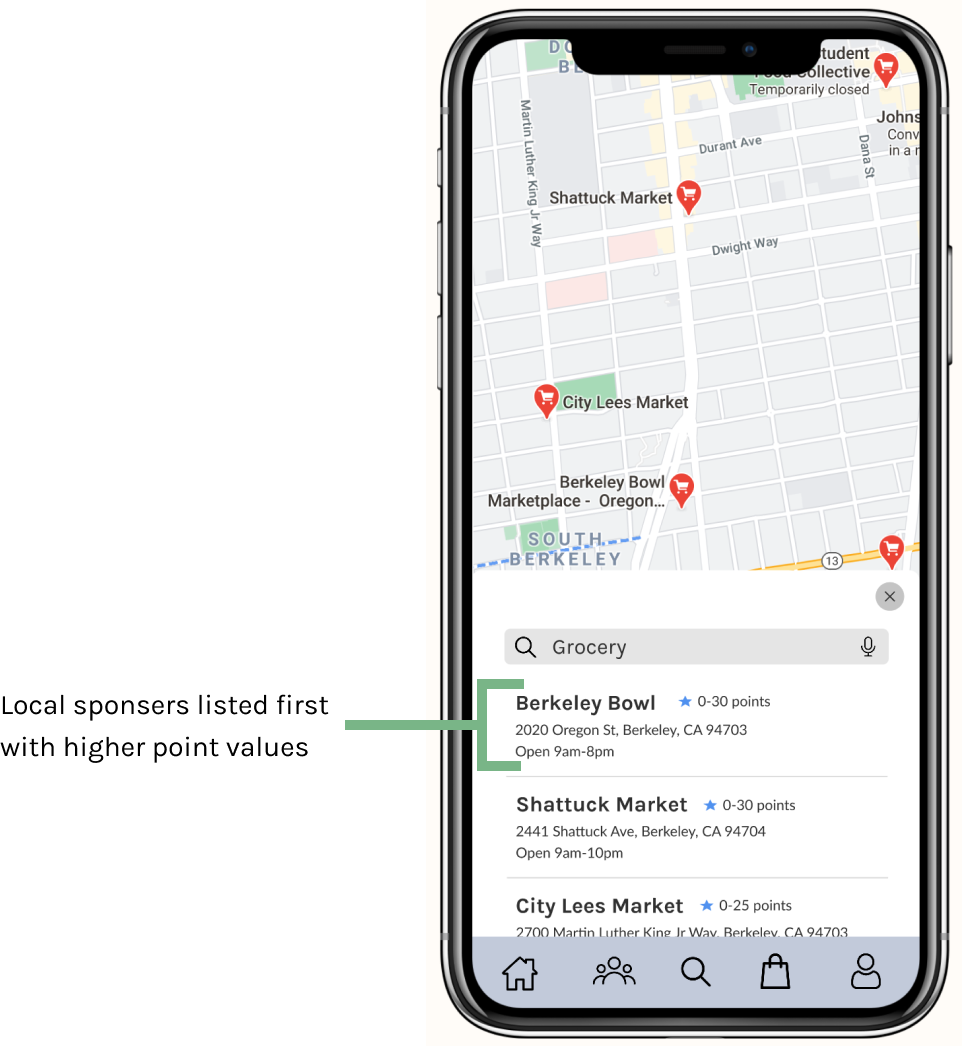
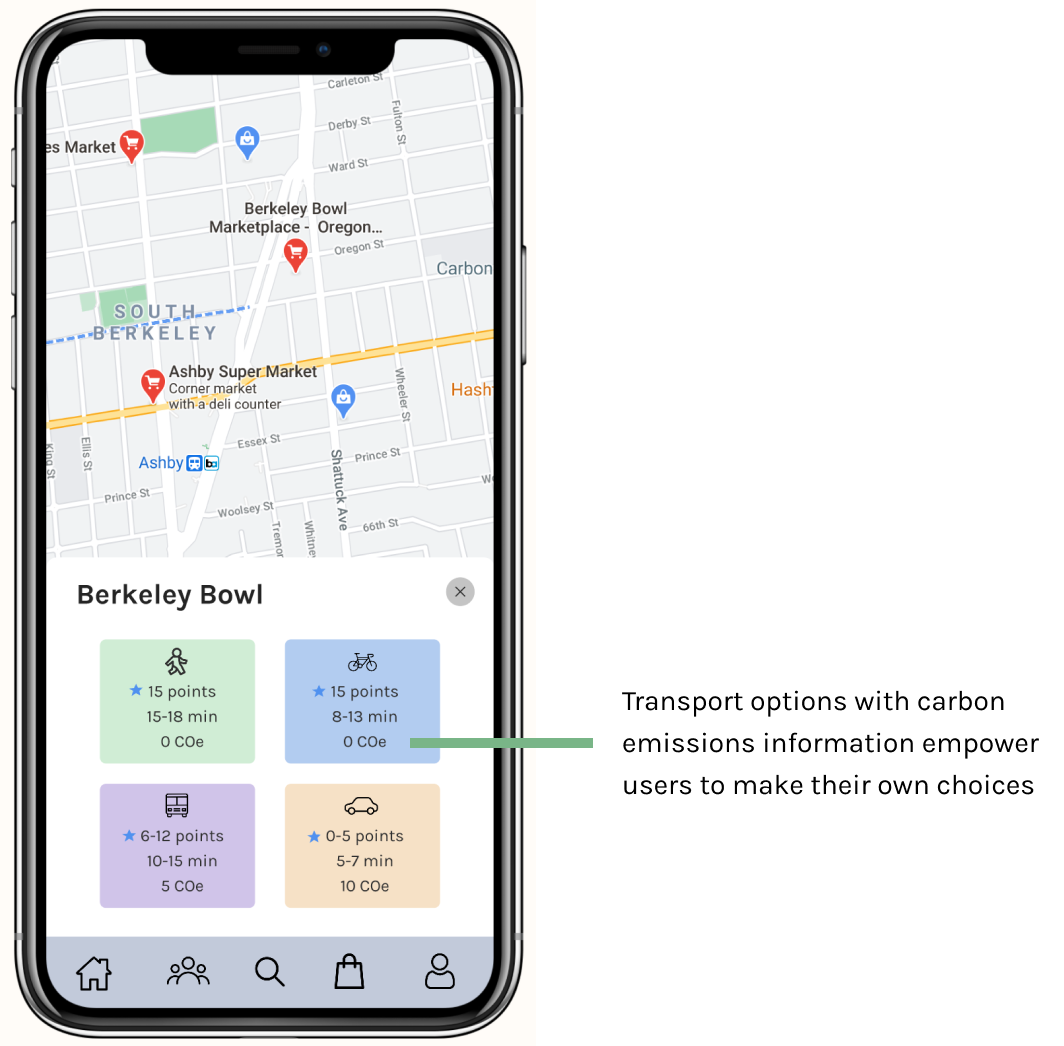
The navigation page lists local sponsors with higher point values first, driving traffic towards them in exchange for prizes we provide for free to our users. This makes the app accessible to people of all socioeconomic backgrounds, while helping local businesses through the pandemic. Navigation options with carbon emissions estimates give users a brief overview of alternative transportation options, and equips users with the information to make carbon neutral choices.
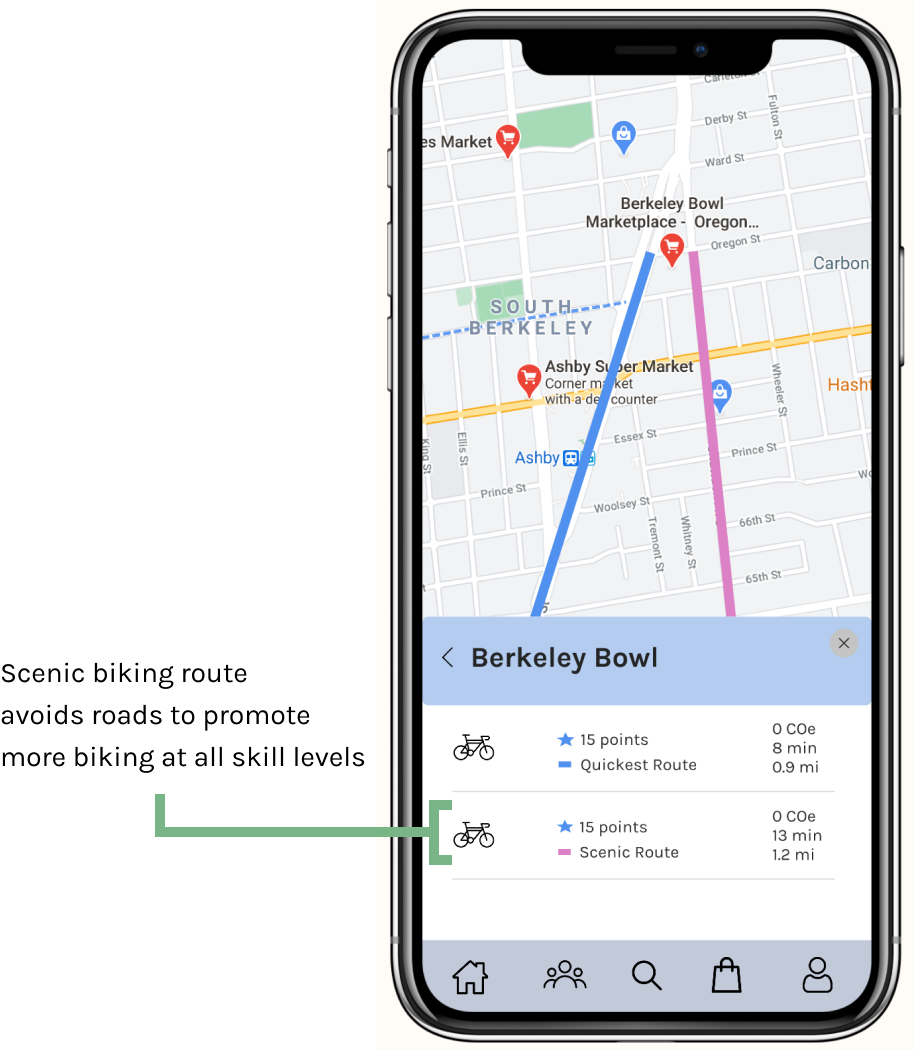
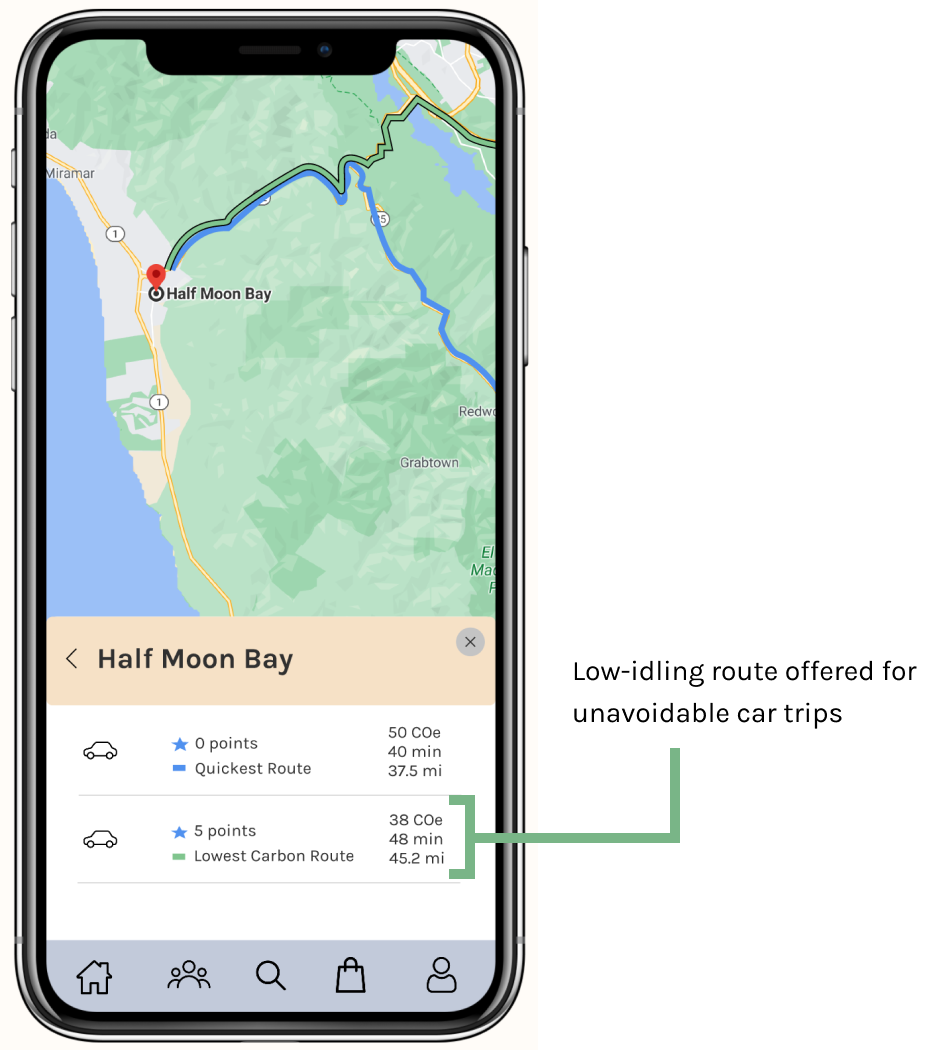
Going back to our mentors feedback, I included biking routes to better suit the bay area user base. The addition of a scenic bike route aims to encourage beginners bikers who may not feel confident biking on roads yet, and provide experienced bikers with an alternate route. For unavoidable car trips, a lower carbon route is offered.
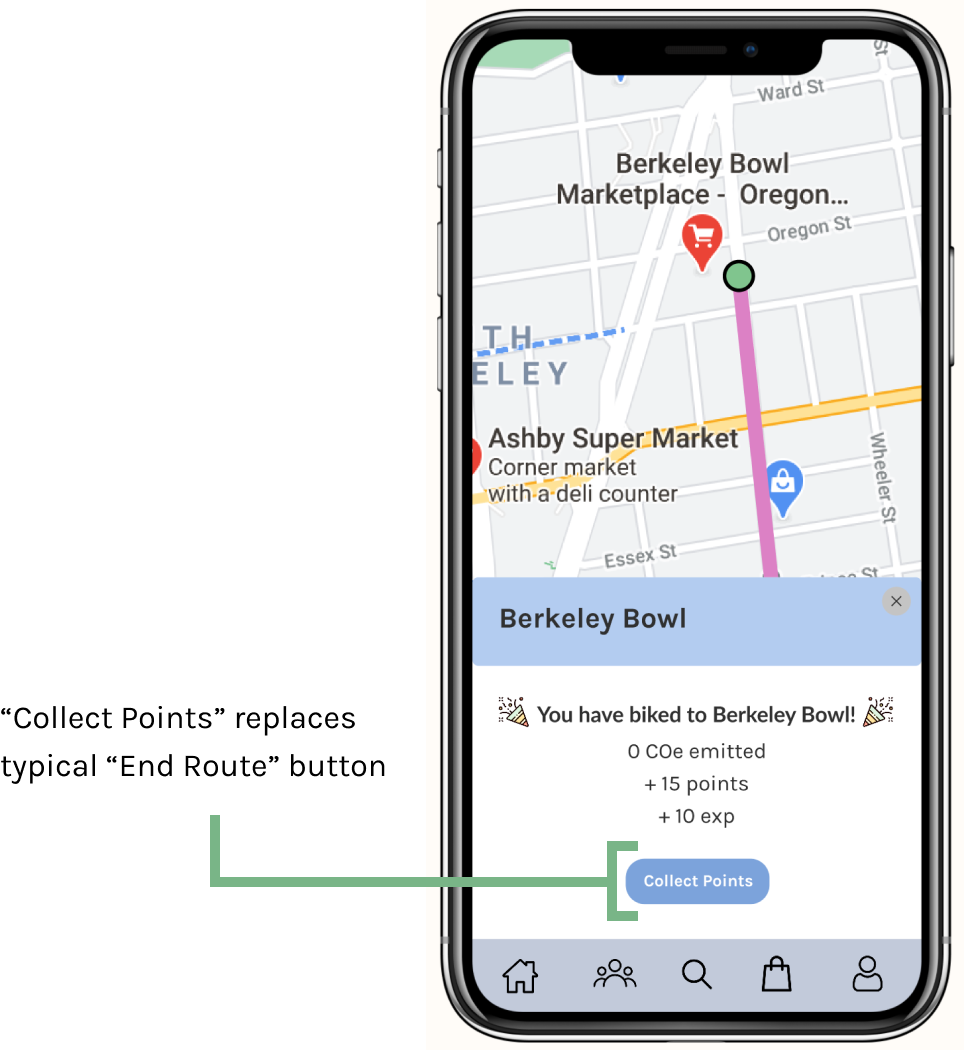
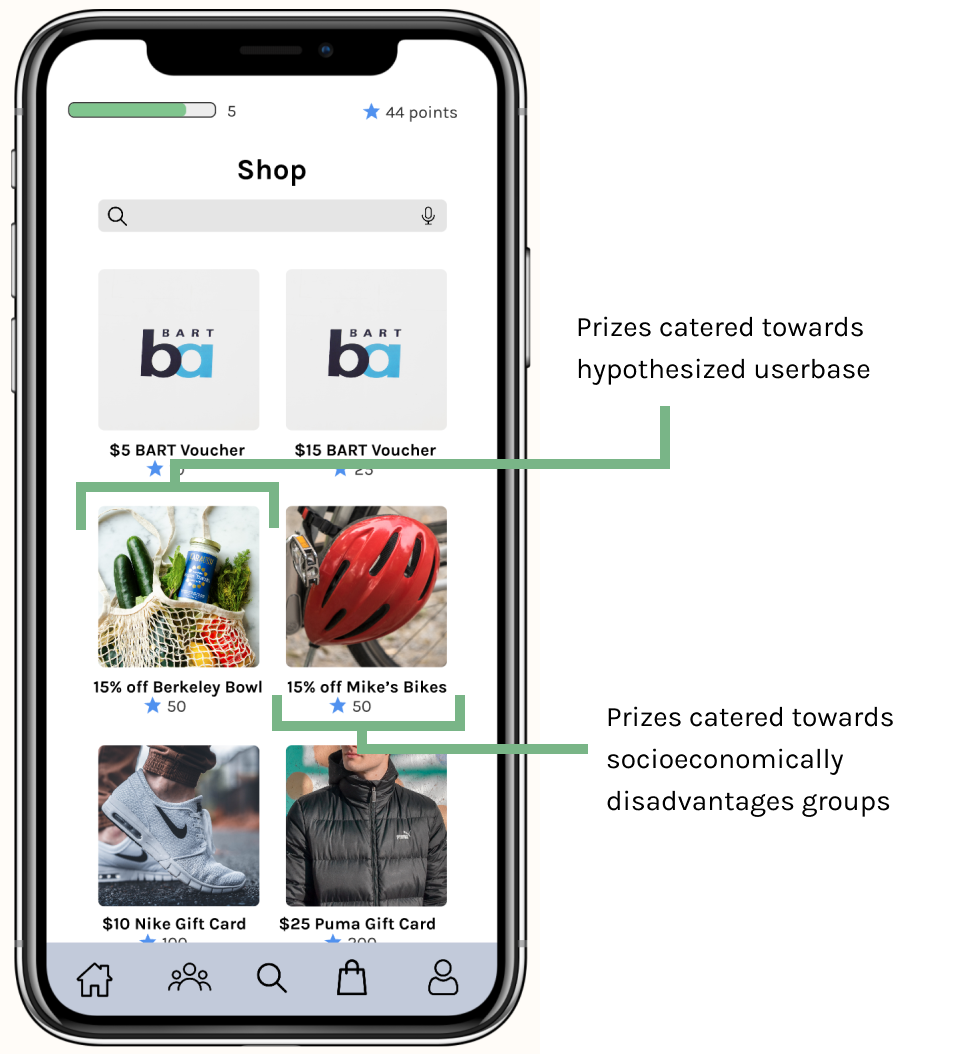
Route ends with a “Collect Points” button that mimics completion of a task found in games, and gives users a sense of achievement. The prize shop is filled with prizes such as athletic gear gift cards that enable users to continue making carbon neutral choices. Prizes such as grocery store discounts specialized for socioeconomically disadvantaged people aim to increase inclusivity.

Connecting with Mentors and Further Improvements
Through this designathon I practiced conducting user research, creating app designs, incorporating feedback, and presenting my designs to judges and mentors.
My favorite part of designing this app was meeting with our mentors, and getting feedback from judges. Even though we were not able to conduct any user interviews, the mentors and judges provided valuable insight into many aspects of the app we had not thought of before. From the inclusion of bike routes, to the funding of prizes, their feedback really pushed me to think past the aesthetic design of the app and into the function behind it.
I’m happy with the final design and features of the app, but if we had more time I would have liked to conduct some user interviews with the mockups, and iterate through some more designs. Though we had feedback from judges/mentors, and did demographic research, I think that conducting some usability tests could have helped improve the user flow further, and made the app more useful for Berkeley residents.